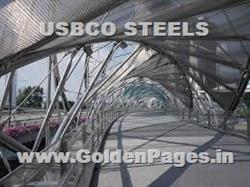USBCO STEELS P.LTD.
Featured Products
Highest quality standards are achieved through the implementations of latest technology, decades of experience and everlasting moral values , which have helped us to retain our customers as well as multiply them.
Welcome to USBCO STEELS P.LTD.
High Speed Steels

High Speed Steels
High-speed steels contain molybdenum and tungsten. They are hardened to 62-67 HRC and maintain this hardness in service temperatures as high as 540° C. Their properties are high wear resistance, high hardness at elevated and low temperatures, and excellent toughness. Typical applications: cutting-off tools (knives, drills, milling cutters, etc.), rolls for cold rolling, cold-work tools.
Cold Working Tool Steels

Cold Working Tool Steels
Cold-work steels have high chromium contents. They ensure high surface hardness, good toughness and compressive strength, and provide excellent wear resistance. Typical applications include cold-work tools, cutting-off tools, rolls for cold rolling, measuring tools, etc.
Plastic Mould Steels

Plastic Mould Steels
Increasing use of plastic products expands the use of steels for plastic mould applications. Manufacturers of plastic products need dies with a long operation period that will retain their high standard quality on a continuous basis. When selecting steel for plastic moulds, the following major factors are of vital importance : type of plastics, plastic moulding method, size and shape of product and/or die, size of series, demanded product surface quality, operation mode, preparation of dies. Steels for plastic moulds need to have the following characteristics : high wear and corrosion resistance, hardness, toughness, good polishability, surface texture properties, machinability, minimal dimensional changes in heat treatment.
Special Steels

Special Steels
Stainless, acid- and heat-resistant steels have an excellent resistance to corrosive media, provide high strength and elongation, and high thermal stability. Stainless steels are commonly divided into five groups: martensitic stainless steels, ferritic stainless steels, austenitic stainless steels, Duplex (ferritic-austenitic) stainless steels, and precipitation-hardening stainless steels. Because of their outstanding properties, they are used in chemical industry, in mechanical engineering, in food industry, and in the energy, medicine, traffic and transport industries.
Alloy Construction Steels

Alloy Construction Steels
During the last fifty years, engineers have demanded steels with higher and higher tensile strength, together with adequate ductility. This has been particularly so where lightness is desirable, as in the automobile and aircraft industries. The principal alloying elements added to steel in widely varying amounts either singly or in complex mixtures are nickel, chromium, manganese, molybdenum, vanadium, silicon and cobalt. In regard to alloying elements, these steels are known as low-alloyed steels and alloyed steels. These steels are used as case hardening steels, quenched & tempered steels, free-cutting steels, nitriding steels, surface hardening steels, spring steels and high-strength steels. Alloyed steels contain carbon and a higher amount of alloying elements such as nickel, chromium, manganese, cobalt, niobium and vanadium. These elements are added to improve mechanical properties, ductility and other steel service properties.
Our Vision
* To embrace new technologies and methods. * To give unsurpassed products and services to the clients. * To constantly look for improvement and changes.










